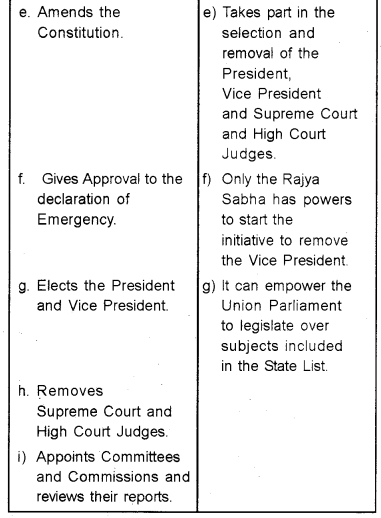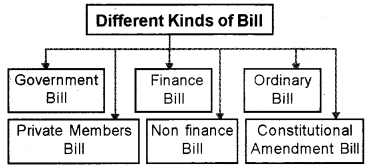Kerala Plus one Political Science Chapter Wise Questions and Answers Chapter 5 Legislature
Legislature Questions and Answers
Question 1.
A Parliament is necessary for the existence of democracy. Do you agree? Explain.
Answer:
The legislature is the Committee that makes laws for the day-to-day administration of the country and for the protection of the freedom and rights of its citizens. The laws that are carried out by the Executive are made by the Legislature. The people in a country through their right to’ vote choose their representatives. The Legislature thus established democratically is responsible to the people. In different countries, different types of Legislature can be found. It is based on the relations between the Executive and Legislature that governments are divided into Parliamentary and Presidential systems.
Question 2.
Name the two Houses of Parliament.
Answer:
Lok Sabha and Rajya Sabha
Question 3.
Who is the present Lok Sabha Speaker?
Answer:
Sumatra Mahakam
Question 4.
What are the powers and functions of Lok Sabha?
Answer:
- Legislation (law-making)
- Controlling the Executive
- Financial responsibilities
- Representation
- Discussions
- Administrative responsibilities
- Election responsibilities
- Judicial responsibilities
Question 5.
Prepare a table showing the powers of Lok Sabha and Rajya Sabha.
Answer:


Question 6.
A bill when passed in the Indian Parliament becomes a law. What do you understand by a bill?
Answer:
A bill is the draft of the proposed law. If the Parliament approves the draft, it becomes a law. The law is to be approved by the President.
Question 7.
There are several procedures fora bill presented in the Parliament to become a law. Explain the procedure.
Answer:
Legislative Procedure in India: The procedure for passing the bills in the Parliament is explained in articles 107 to 122. According to that, each bill has to pass through 5 phases including 3 readings in the Houses.
a) First Reading: This is the presentation of the bill. After getting the permission of the House, a member presents the bill with a statement.
If the bill faces opposition, the one who presented the bill and the one objecting it is given opportunity to explain their stands. If the majority votes in favor of the Bill, it is published in the Government Gazette. If the bill is not very controversial, there is a precedent that there is no discussion in the first reading.
b) Second Reading: This is the 2nd phase. At this stage, all the important points of the bill are discussed. The presenter will ask the House to consider it urgently. Or he may request the bill to be sent to a Select Committee ora Joint Committee of both the Houses for consideration. He may also ask the bill to be circulated forgetting public opinion. Normally the bill is sent to a Select Committee.
c) The Committee Stage: This is the 3rd stage. The members to this Committee are appointed by the House. The Committee Chairman decides the time, date and venue of the meeting. The Select Committee will have members from the Opposition. The Members study the bill clause by clause and prepares a report to be presented in the House.
d) Report Stage: This is the 4th stage. The presenter asks the House to discuss the bill on the day it is scheduled for discussion. The Report may be unanimous or with differences in opinion. In the light of the Report, the House discusses each condition in the bill. This discussion may take quite some time. Each item in the bill is discussed extensively and then it is put to vote. During this time serious changes may happen in the bill and therefore this is the most crucial stage.
e) Third Reading: This is the last stage. On the appointed day the bill is presented in the House for final approval. No serious change is brought at this stage. Changes may be orally presented and quickly resolved. At the end of the discussion, the bill is put to vote. If the bill receives favourable vote from the majority of members present and voting, the bill is deemed to have passed. Then the bill is sent to the second House.
Question 8.
Complete the following flow chart

Answer:

Question 9.
Lok Sabha is more powerful than the Rajya Sabha. Comment.
Answer:
The Rights and Responsibilities of the Lok Sabha: The Lok Sabha has Legislative, Financial, Administrative and Election responsibilities. In the matter of ordinary law-making, Lok Sabha has greater power. If a bill passed by the Lok Sabha is rejected by the Rajya Sabha, the President can call a joint meeting of both the Houses. Since Lok Sabha has greater number of members, the Rajya Sabha will have to go with the Lok Sabha verdict. The Rajya can only delay things a bit. A bill may originate in any House, normally important bills are presented first in the Lok Sabha. Financial Bills can originate only in the Lok Sabha. Since the Lok Sabha has the freedom to reject any suggestions on Financial Bills, it has the monopoly over them.
Lok Sabha controls the Executive in the day-to-day administration. The Central Ministry is collectively responsible to the Lok Sabha. The Ministry will have to resign the moment it loses the confidence of the Lok Sabha. It can also bring a Non-Confidence motion. By asking questions, through resolutions and discussions, the Lok Sabha maintains control over the government. When the Appropriation bills are brought, the members get a chance to discuss the successes and failures of each department. Members of the Lok Sabha have voting right in the election of the President and Vice President. It has equal authority with the Rajya Sabha to bring any amendment. It has equal rights with the Rajya Sabha in impeaching the President, in removing Supreme Court and High Court Judges, in approving Resolutions for Emergency and Ordinances.
Question 10.
What do you mean by Money Bill?
Answer:
Money bills are those that deal with economic matters. They can originate only in the Lok Sabha. The process of Money Bill is different. After passing it, the Lok Sabha passes it on to the Rajya Sabha for suggestions. But Rajya Sabha has no power to change it or reject it. In 14 days’ time after the receipt of the bill by the Rajya Sabha, it should send it back to the Lok Sabha with suggestions. The suggestions can be accepted or rejected by the Lok Sabha. If the bill is not returned within 14 days, it will be considered to have been passed by both Houses. The Rajya Sabha has virtually no important role to play in the Money Bills.
Question 11.
How any members are there in the Lok Sabha?
Answer:
It has 545 members – 543 elected and 2 nominated.
Question 12.
Suggest the instruments of Parliamentary control.
Answer:
- Discussions and debates.
- Approving of rejecting the laws.
- Control through finances
- Motion of No-Confidence
Question 13.
The first item in the time-table of the Parliament is Question-Answer session. Then comes the Zero hour. What do you know about the Zero hour?
Answer:
When the Question-Answer session finishes, the Zero hour starts. It starts at 12 Noon and that is why it is called the Zero hour. During the Zero hour, urgent matters can be raised without giving prior notice.
Question 14.
Point out the importance of the law of anti-defection.
Answer:
Defection is when an elected member of a party refuses to obey party-whip and joins with other parties. Law of anti-defection makes such defections unlawful. The law envisages that the membership of the defected member should be canceled. This law ensures the stability of the government.
Question 15.
How many members are there in the Indian Parliament from Kerala?
Answer:
20 in the Lok Sabha and 9 in the Rajya Sabha.
Question 16.
Prepare a note on Parliamentary supremacy.
Answer:
Although both Britain and India have Parliamentary (Cabinet) System, the Parliaments in both countries do not have the same status. Since Britain has no written constitution, its Parliament has unlimited powers. It can pass or reject any law. Courts can’t question the Parliament there. The Parliament can even ignore Court decisions. In short, there is nothing the Parliament can’t do there.
Question 17.
Match the following:
| A | B |
| Lower House of the Parliament | 17 April 1952 |
| Upper House of the Parliament | Lok Sabha |
| Formation of the Rajya Sabha | Rajya Sabha |
| Formation of the Lok Sabha | 3 April 1952 |
| Parliament | 1985 |
| Amendment to Anti-Defection Law | Power of Impeachment |
Answer:
| A | B |
| Lower House of the Parliament | Lok Sabha |
| Upper House of the Parliament | Rajya Sabha |
| Formation of the Rajya Sabha | 3 April 1952 |
| Formation of the Lok Sabha | 17 April 1952 |
| Parliament | Power of Impeachment |
| Amendment to Anti-Defection Law | 1985 |
Question 18.
What do you mean by Select Committee? How is it formed and operated?
Answer:
When the House wants a bill to be sent to the Select Committee, a Select Committee is formed. A Select Committee is formed to study a bill in detail and make its report. The chairman of the Committee is nominated by the Speaker. After studying the bill carefully, the committee presents its report to the House. When the work is over the Select Committee is disbanded.
Question 19.
Explain (a) Question Hour,
(b) Zero Hour and
(c) Adjournment Motion.
Answer:
Parliament meetings start at 11 a.m. Up to 12 Noon, it will be Question-Answer time. This is the time set apart for the members to ask questions to the Ministers on a particular topic.
When the Question Hour finishes, the Zero Hour starts. Since it starts at 12 Noon it is called the Zero hour. During the Zero hour, urgent matters can be raised without giving prior notice. 5 to 10 minutes are given for each matter. The agenda of the Parliament is pre-determined. But with the permission of the speaker, this can be changed. Keeping the pre-determined agenda away, the Speaker at times allows members to present matters of urgent importance. Adjournment Motion is for that.
Question 20.
The Upper House of the Parliament is …………
Answer:
Rajya Sabha
Question 21.
From which year was Rajya Sabha known by that name?
a) 1950
b) 1951
c) 1954
d) 1956
Answer:
1954
Question 22.
Lok Sabha was formed on ……….
Answer:
17 April 1952
Question 23.
When does the Zero Hour of the Parliament start?
Answer:
At 12 Noon
